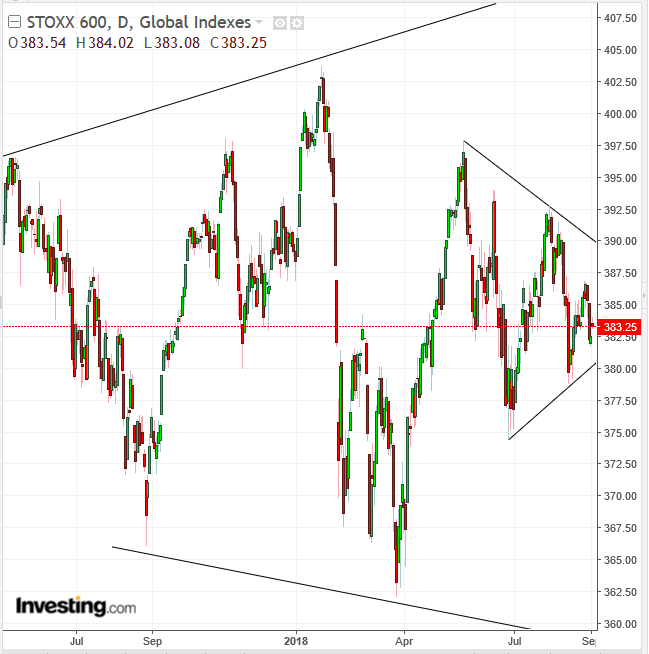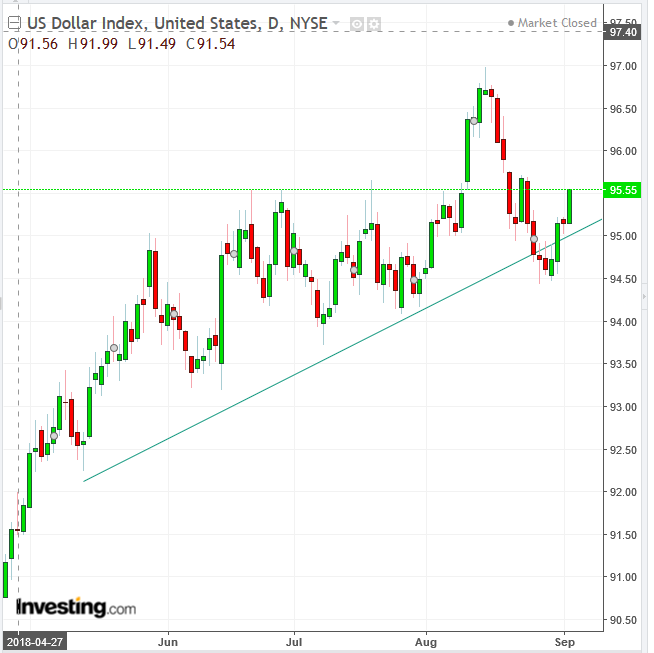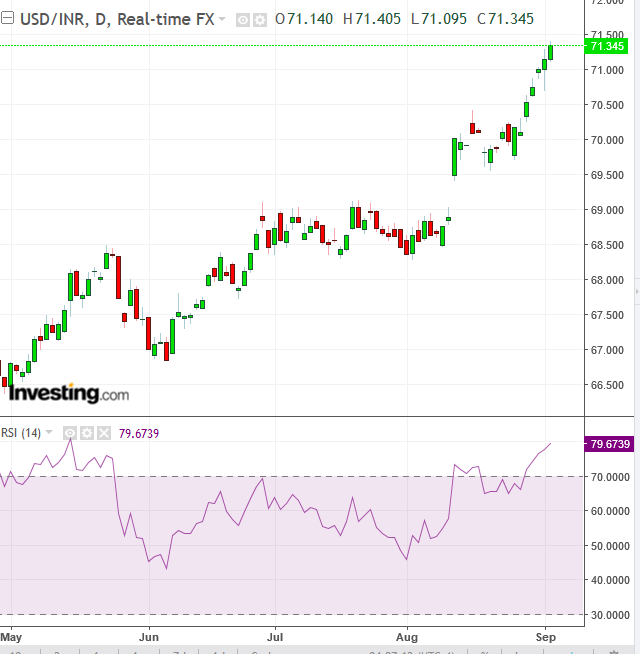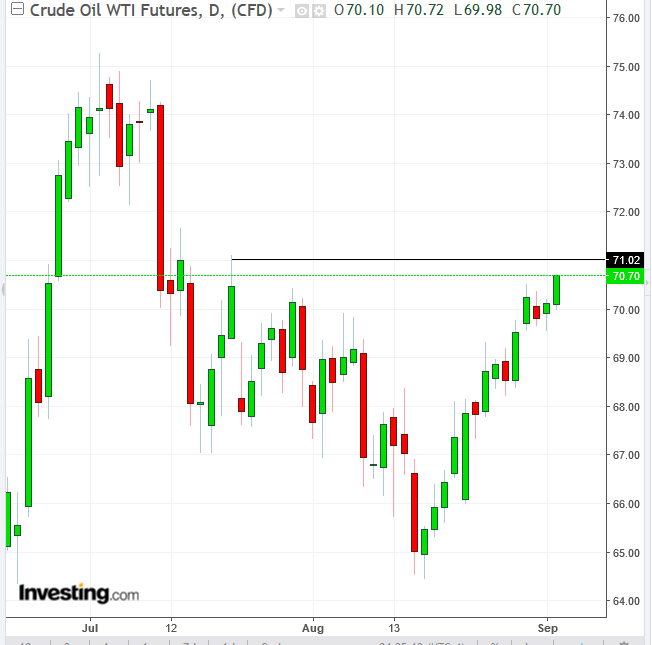- Global stocks downbeat amid renewed trade headwinds
-
Oil jumps on Gulf hurricane and Iranian supply glitches
-
Indian rupee hits all-time low
-
GBP begins September on track to hit a sixth straight month of decline
-
BoE Governor Mark Carney testifies on August's inflation report and monetary policy decision on Tuesday
-
Also on Tuesday, US PMI data are due
-
Executives from Facebook (NASDAQ:FB), Twitter(NYSE:TWTR) and Google (NASDAQ:GOOGL) testify on the role of social media in the Russia meddling with the 2016's US presidential election.
-
US employment reports for August are released on Friday.
-
Futures on the S&P 500 gained 0.3 percent.
-
The MSCI All-Country World Index dropped less than 0.05 percent to the lowest level in more than a week.
-
The MSCI Emerging Market Index gained 0.1 percent, the first advance in a week and the most significant climb in more than a week.
-
The Dollar Index climbed 0.43 percent to the highest level in about two weeks.
-
The euro slipped 0.4 percent to $1.1578, the weakest level in more than a week.
-
The Japanese yen lost 0.3 percent to 111.36 per dollar.
-
The Turkish lira fell 0.3 percent to 6.6575 per dollar, the weakest level in more than three weeks.
-
South Africa’s rand slipped 0.8 percent to 14.986 per dollar, the weakest level in more than two years.
-
The MSCI Emerging Markets Currency Index declined 0.3 percent to the lowest level in 14 months.
-
The yield on 10-year Treasurys gained two basis points to 2.88 percent, the most significant advance in a week.
-
Germany’s 10-year yield climbed two basis points to 0.35 percent.
-
Britain’s 10-year yield dropped two basis points to 1.404 percent, the lowest level in more than a week.
-
The Bloomberg Commodity Index slipped 0.3 percent to the lowest level in a week on the most significant fall in a week.
-
West Texas Intermediate crude gained 0.7 percent to $70.29 a barrel, the highest level in eight weeks.
-
LME copper fell 1 percent to $5,910.00 per metric ton, reaching the lowest level in almost three weeks on its fifth consecutive decline.
-
Gold lost 0.5 percent to $1,195.84 an ounce, the weakest level in more than a week.
Key Events
European equities posted a mixed performance in Tuesday's early trade, starting on the right foot before slipping into the red following a lackluster session in Asia. US futures on the S&P 500, Dow and NASDAQ 100 are also mixed, with NASDAQ futures pointing to a possible rebound during the upcoming US session.
Meanwhile, the dollar continues to gain strength on lingering fears of contagion from emerging market currencies.

The pan-European STOXX 600 was initially boosted by gains in banks and utilities shares. Technically, however, the supply-demand dynamic reached an impasse, as both sides seemed equally determined, trading within a symmetrical triangle since May. Note, however, that the broadening pattern since May of 2017 demonstrates a lack of leadership and often appears at market tops.
Earlier, during Asian trade, equity markets lacked direction. China's Shanghai Composite outperformed its regional peers, climbing 1.1 percent, ending a straight, five-day decline, as dip buyers took advantage of underpriced real estate and banking stocks. The role of dip buyers in today's equity bounce back means we shouldn't necessarily assume that investors have got over their trade war worries. In fact, the head of Asia trading strategy at Citigroup, Mohammed Apabhai, told Bloomberg that he expects Chinese stocks to continue falling.
Hong Kong’s Hang Seng was the day's second best regional performer with a 0.94 percent advance. South Korea’s KOSPI gained 0.38 percent. Japan’s Nikkei 225 retreated 0.1 percent, even as the yen fell by more than 0.3 percent, boosting exports, as the country issued evacuation advisories for more than a million citizens after typhoon Jebi hit the Japanese west coast.
Australia’s S&P/ASX 200 underperformed more markedly, dragged 0.28 percent lower by losses in banks and energy shares. The former sector suffered from heightened regulatory pressure and calls by the Chairman of the Australian Prudential Regulation Authority, Wayne Byres, to cut compensation packages for senior bank executives.
Global Financial Affairs
US markets were closed yesterday in observance of Labor Day. On Friday, stocks ended mixed amid thin trading—almost 14 percent below the average levels, ahead of the long holiday weekend. The S&P 500 eked out a paltry 0.01 percent gain to finish last week's trading, weighed by automakers, after trade discussions in Washington stalled. Talks are scheduled to resume on Wednesday.
The Dow Jones Industrial Average gave up 0.09 percent on Friday, while the NASDAQ Composite and the Russell 2000 gained some ground, ticking 0.26 percent and 0.48 percent higher respectively.

The greenback edged higher this morning on persistent concerns that the recent emerging markets selloff would spread to other markets. Technically, today’s solid candle marks the third USD advance within four sessions, which includes yesterday even though US equity markets were closed. The bounce confirms the uptrend line since mid-May.
Emerging markets shares recouped some losses after dropping more than 2 percent for the week through Monday. South Africa’s rand and Mexico’s peso were among the worst-performing EM currencies. From a year-to-date perspective, the Indian rupee is one of the worst-performing EM currencies. Bloomberg suggests that technicals show the currency is oversold, after hitting a new record low on Monday, sending the RSI to above the 75 level.

The USD/INR RSI reached the second half of the 79 level, scratching 80—the highest position for this measure since May. The conditions that led to the rupee's demise include a strong dollar, expensive oil and weak emerging markets. Still, Kotak Mahindra Bank's currency analyst Anindya Banerjee said:
"You may get a pullback, say to 69.70, but nothing beyond that. If oil refuses to fall, and with EM looking very brittle along with an escalating trade-war rhetoric, the template is looking negative for the rupee.”
In other FX news, the pound sterling slid for a fourth day ahead of the Bank of England's parliamentary testimony on its latest inflation reports. If price drops stretch over September, it would be the sixth straight month of declines for cable.

Oil edged 0.84 percent higher, hitting a high for the past month, trading at the height of the session after oil rigs in the Gulf of Mexico were evacuated ahead of a hurricane, and on reports the US is putting pressure on Iranian oil sales even before sanctions against the Middle Eastern country kick in in early November. Energy expert John Kilduff sees the latter factor alone as capable of propelling oil prices as much as 30 percent higher, toward $100.
Technically, the price of WTI is hitting resistance at the $71 level since July.
Up Ahead
Market Moves
Stocks
Currencies
Bonds
Commodities
